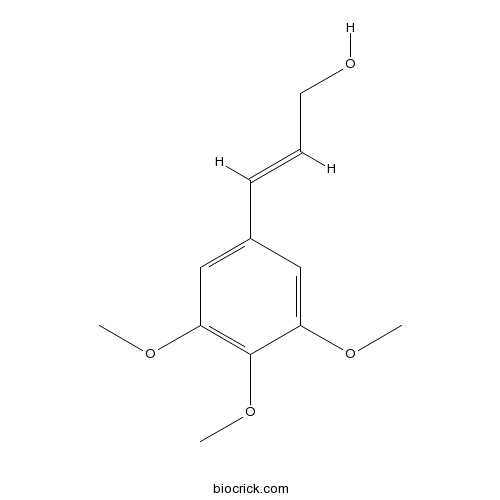3,4,5-Trimethoxycinnamyl alcoholCAS# 30273-62-2 |

Quality Control & MSDS
3D structure
Package In Stock
Number of papers citing our products

| Cas No. | 30273-62-2 | SDF | Download SDF |
| PubChem ID | 6436306 | Appearance | Oil |
| Formula | C12H16O4 | M.Wt | 224.3 |
| Type of Compound | Phenylpropanoids | Storage | Desiccate at -20°C |
| Solubility | Soluble in Chloroform,Dichloromethane,Ethyl Acetate,DMSO,Acetone,etc. | ||
| Chemical Name | (E)-3-(3,4,5-trimethoxyphenyl)prop-2-en-1-ol | ||
| SMILES | COC1=CC(=CC(=C1OC)OC)C=CCO | ||
| Standard InChIKey | HZDDMDAKGIRCPP-SNAWJCMRSA-N | ||
| General tips | For obtaining a higher solubility , please warm the tube at 37 ℃ and shake it in the ultrasonic bath for a while.Stock solution can be stored below -20℃ for several months. We recommend that you prepare and use the solution on the same day. However, if the test schedule requires, the stock solutions can be prepared in advance, and the stock solution must be sealed and stored below -20℃. In general, the stock solution can be kept for several months. Before use, we recommend that you leave the vial at room temperature for at least an hour before opening it. |
||
| About Packaging | 1. The packaging of the product may be reversed during transportation, cause the high purity compounds to adhere to the neck or cap of the vial.Take the vail out of its packaging and shake gently until the compounds fall to the bottom of the vial. 2. For liquid products, please centrifuge at 500xg to gather the liquid to the bottom of the vial. 3. Try to avoid loss or contamination during the experiment. |
||
| Shipping Condition | Packaging according to customer requirements(5mg, 10mg, 20mg and more). Ship via FedEx, DHL, UPS, EMS or other couriers with RT, or blue ice upon request. | ||
| Description | 1. 3,4,5-Trimethoxycinnamyl alcohol shows significant antimicrobial and cytotoxic activities. |
| Targets | Antifection |

3,4,5-Trimethoxycinnamyl alcohol Dilution Calculator

3,4,5-Trimethoxycinnamyl alcohol Molarity Calculator
| 1 mg | 5 mg | 10 mg | 20 mg | 25 mg | |
| 1 mM | 4.4583 mL | 22.2916 mL | 44.5831 mL | 89.1663 mL | 111.4579 mL |
| 5 mM | 0.8917 mL | 4.4583 mL | 8.9166 mL | 17.8333 mL | 22.2916 mL |
| 10 mM | 0.4458 mL | 2.2292 mL | 4.4583 mL | 8.9166 mL | 11.1458 mL |
| 50 mM | 0.0892 mL | 0.4458 mL | 0.8917 mL | 1.7833 mL | 2.2292 mL |
| 100 mM | 0.0446 mL | 0.2229 mL | 0.4458 mL | 0.8917 mL | 1.1146 mL |
| * Note: If you are in the process of experiment, it's necessary to make the dilution ratios of the samples. The dilution data above is only for reference. Normally, it's can get a better solubility within lower of Concentrations. | |||||

Calcutta University

University of Minnesota

University of Maryland School of Medicine

University of Illinois at Chicago

The Ohio State University

University of Zurich

Harvard University

Colorado State University

Auburn University

Yale University

Worcester Polytechnic Institute

Washington State University

Stanford University

University of Leipzig

Universidade da Beira Interior

The Institute of Cancer Research

Heidelberg University

University of Amsterdam

University of Auckland

TsingHua University

The University of Michigan

Miami University

DRURY University

Jilin University

Fudan University

Wuhan University

Sun Yat-sen University

Universite de Paris

Deemed University

Auckland University

The University of Tokyo

Korea University
- Bisline
Catalog No.:BCN2062
CAS No.:30258-28-7
- Rosiglitazone HCl
Catalog No.:BCC2269
CAS No.:302543-62-0
- Potassium 7-hydroxynaphthalene-1-sulfonate
Catalog No.:BCN8289
CAS No.:30252-40-5
- 1-Hydroxybaccatin I
Catalog No.:BCN5211
CAS No.:30244-37-2
- Ingenol
Catalog No.:BCN2333
CAS No.:30220-46-3
- Effusanin A
Catalog No.:BCN5210
CAS No.:30220-43-0
- Arenobufagin 3-hemisuberate
Catalog No.:BCN7837
CAS No.:30219-16-0
- Retinoic acid
Catalog No.:BCN2185
CAS No.:302-79-4
- DL-Alanine
Catalog No.:BCN8539
CAS No.:302-72-7
- Aconitine
Catalog No.:BCN1014
CAS No.:302-27-2
- Hydroxyprogesterone acetate
Catalog No.:BCC8997
CAS No.:302-23-8
- Desoxyrhaponticin
Catalog No.:BCN2954
CAS No.:30197-14-9
- TCS 46b
Catalog No.:BCC7482
CAS No.:302799-86-6
- Ciliobrevin A
Catalog No.:BCC3939
CAS No.:302803-72-1
- Ro 01-6128
Catalog No.:BCC7922
CAS No.:302841-86-7
- Ro 67-4853
Catalog No.:BCC7921
CAS No.:302841-89-0
- Dasatinib (BMS-354825)
Catalog No.:BCC1281
CAS No.:302962-49-8
- 2-Amino-N-(2-chloro-6-methylphenyl) thiazole-5-carboxamide
Catalog No.:BCC8551
CAS No.:302964-24-5
- Clinofibrate
Catalog No.:BCC5020
CAS No.:30299-08-2
- Heliotrine
Catalog No.:BCN1982
CAS No.:303-33-3
- Lasiocarpine
Catalog No.:BCN2001
CAS No.:303-34-4
- Methenolone enanthate
Catalog No.:BCC9029
CAS No.:303-42-4
- Gossypol
Catalog No.:BCN2702
CAS No.:303-45-7
- Ochratoxin A
Catalog No.:BCC7008
CAS No.:303-47-9
Antimicrobial and cytotoxic constituents of Loranthus globosus.[Pubmed:12727502]
Fitoterapia. 2003 Apr;74(3):308-11.
(+)-Catechin, 3,4-dimethoxycinnamyl alcohol and 3,4,5-Trimethoxycinnamyl alcohol were isolated from the barks of Loranthus globosus. All compounds showed significant antimicrobial and cytotoxic activities.
Toxicological studies of two compounds isolated from Loranthus globosus Roxb.[Pubmed:19093449]
Pak J Biol Sci. 2007 Jun 15;10(12):2073-7.
The sub-acute toxicities of two compounds 3,4-dimethoxycinnamyl alcohol (1) and 3,4,5-Trimethoxycinnamyl alcohol (2) isolated from the plant Loranthus globosus Roxb were studied on long Evan's rats. The studies included the gross general observation such as changes in body weight, haematological profiles [total count of Red Blood Cells (RBC) and White Blood Cells (WBC), differential count of WBC, platelet count and Haemoglobin (Hb)%], biochemical parameters of blood [Serum Glutamate Oxaloacetate Transaminase (SGOT), Serum Glutamate Pyruvate Transaminase (SGPT), Serum Alkaline Phosphatase (SALP), urea and creatinine) and histopathology of the liver, kidney, heart and lung of both control and experimental groups of rats. The changes in haematological and biochemical parameters were statistically not significant after the administration of compounds 1 and 2 in a dose of 300 microg/rat/day for consecutive 14 days. No abnormality was found in the histopathology of the liver, kidney, heart and lung in the experimental groups of rats following same dose when compared with control group. This preliminary study suggests that the isolated compounds may be used safely for clinical trial.


